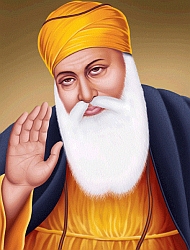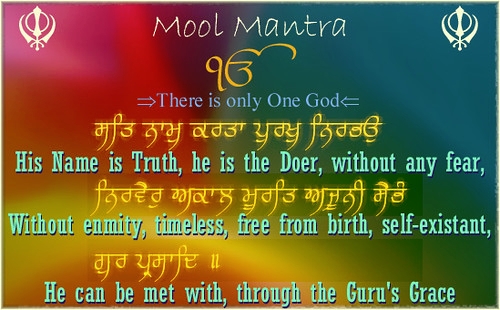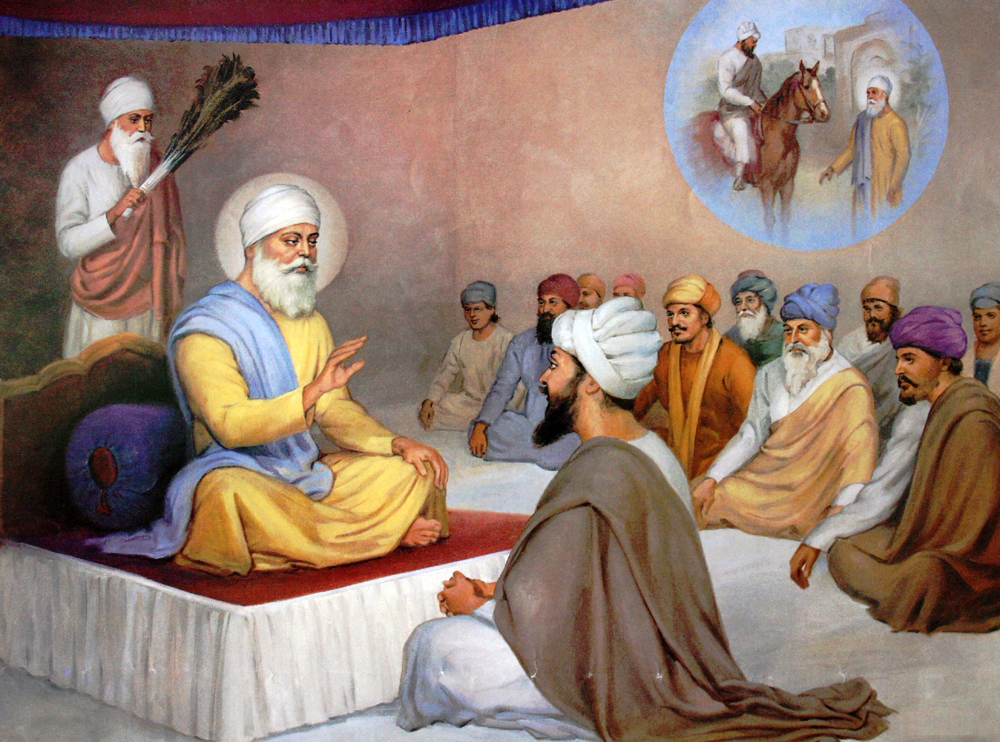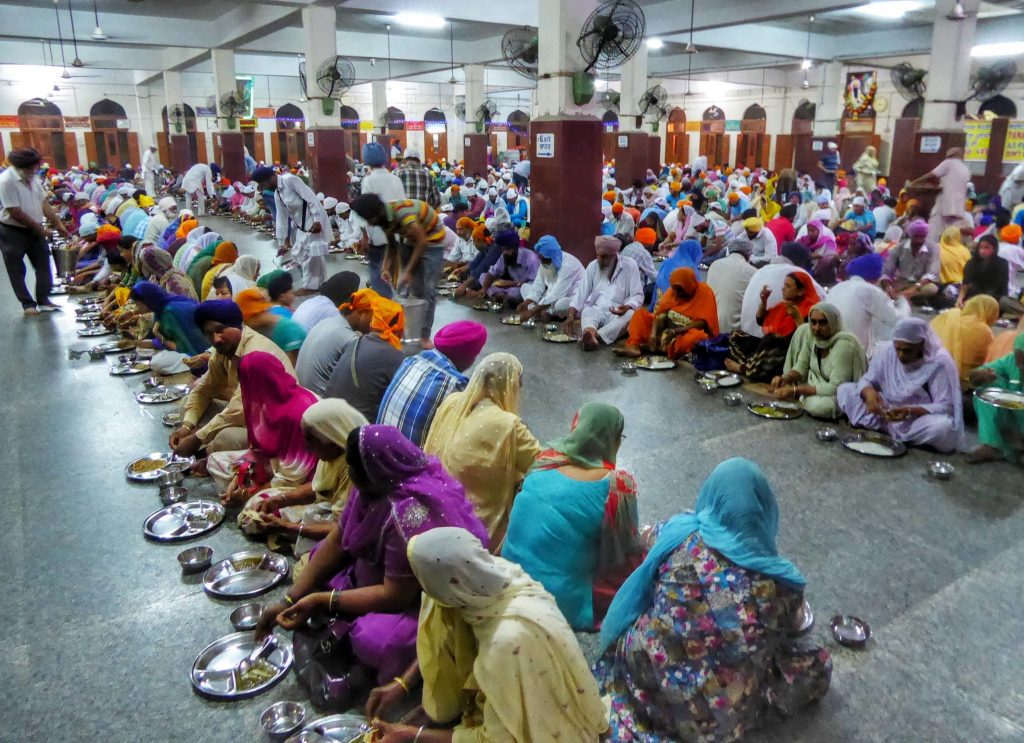 Guru Nanak is named founder of the Sikh religion. ‘Sikh’ means ‘disciple’ and Guru Nanak believed that one can evolve or achieve salvation only through direct contact with a true master or a ‘sadguru’. His religion has spread not only in North India but also in America, Singapore and Africa. Many Sikhs now live in other countries.
Guru Nanak is named founder of the Sikh religion. ‘Sikh’ means ‘disciple’ and Guru Nanak believed that one can evolve or achieve salvation only through direct contact with a true master or a ‘sadguru’. His religion has spread not only in North India but also in America, Singapore and Africa. Many Sikhs now live in other countries.
Guru Nanak 1469 – 1522
Guru Nanak was born on April 15, 1469, at Talwandi, 40 miles from Lahore. As a tribute to him, this place is now called ‘Nankana Sahib’ and is in present Pakistan. His father Kaluchand was a Patwari and his mother’s name was Tripta Devi. An astrologer had predicted that Nanak was a born devotee of God and would achieve spiritual heights and be acknowledged by both Hindus and Muslims alike.
At seven months, the Miharban Janam Sakhi (life story) states, he would already sit in the posture of a yogi. The same account also tells of his education in Sanskrit at the hands of the village pandit and in Persian and Arabic in the Talwandi Muslim school. He rejected the sacred thread ceremony at the age of ten and thwarted his father’s ambition that his son should become an accountant. Though some narratives emphasise his rejection of all things worldly it is more probable that by the time Nanak came to the end of his teens he was an educated man already dissatisfied with the formal Hinduism which was his heritage. Descriptions of his meetings with yogis, sadhus and sants may at very least point to a serious religious quest, supported as they are by a considerable number of references to the terminology, practices and beliefs of such groups in his compositions which are preserved in the Guru Granth Sahib.
A Charitable Disposition
Nanak’s father worried about his future, as he did not seem interested in earning money. He once gave him 20 rupees (a rather large sum for that time) and sent him to Lahore to start a business. Nanak was accompanied by his constant companion Bhai Bala. En route, they came across some hungry sadhus, who were meditating. Nanak spent all the money he had to feed them. And then returned home. Next, his father sent him to stay with his sister Nanki, in Sultanpur. Nanak’s sister, Nanaki, had married Jai Ram, and gone to his town of Sultanpur where he was steward (modi) to Daulat Khan Lodi who later became governor of Lahore. It is not unusual in the Indian tradition to see a younger brother going to the home of his older brother-in-law. Here he also found employment in the service of Daulat Khan. By now he was about sixteen years old.
The considerable number of allusions to governmental structure in his hymns may reflect the knowledge which he gained at this time. Living in a much more Muslim context, as the employee of an Afghan administrator in a town on the main highway from Lahore to Delhi, it is attractive to see this as the period he met Muslim intellectuals and holy men but was again unable to find the answers he was seeking. When he was about nineteen he married and his two sons were born during the next few years. In every janam sakhi account (life story) he was already described as a spiritual preceptor rising before dawn to bathe in the river and after meditation lead his followers in singing kirtan (sacred songs) before returning home for breakfast and work in the nawab’s court. At the end of the day, after dinner, a congregation would gather at his home to sing kirtan far into the night. The janam sakhis, (life stories) however, also describe an experience of enlightenment when he was thirty which preceded Nanak’s emergence as a Guru.

Disappears whilst bathing
One morning Nanak failed to return from his ablutions. His clothes were found on the river bank and the townspeople concluded that he had drowned. Daulat Khan had the river dragged but no body was discovered. After three days Nanak reappeared but remained silent. It was the next day before he spoke and then he made the enigmatic pronouncement: ‘There is neither Hindu nor Mussulman so whose path shall I follow? I shall follow God’s path. God is neither Hindu nor Mussulman and the path which I follow is God’s.’ Explaining what had happened to him he said that he was taken to the court of God and escorted into his presence. There a cup was filled with armrit (nectar) and was given to him with the command, ‘This is the cup of the adoration of God’s name. Drink it. I am with you. I bless you and raise you up. Whoever remembers you will enjoy my favour. Go, rejoice in my name and teach others to do so. I have bestowed the gift of my name upon you. Let this be your calling.’ It is said that his first poetic utterance after this experience was the Mool Mantra in which the concept of the divinity which he had experienced is encapsulated. A passage in the Guru Granth Sahib is said to be another description of his experience.
I was a minstrel out of work,
The Lord gave me employment.
The mighty One instructed me,
‘Night and day, sing my praise.’
The Lord summoned the minstrel
To his High Court.
On me he bestowed the robe of honouring him and singing his praise.
On me he bestowed the Nectar in a cup,
The nectar of his true and holy name.
Those who at the bidding of the Guru Feast
And take their fill of the Lord’s holiness
Attain peace and joy.
Your minstrel spreads your glory
By singing your word. Nanak, through adoring the truth
We attain to the all-highest. (AG 150)
The Emergence of a Guru
From this point onwards the accounts describe him as a Guru, popularly explained among Sikhs as one who dispels ignorance or darkness (gu) and proclaims enlightenment (ru). A series of journeys took him to the main centres of Hinduism and Islam as well as to Sri Lanka and Tibet. He was often accompanied by Mardana, a Muslim disciple and musician. In some narratives Guru Nanak is seen as restoring a religion from the formalism which had overcome it to the truth which lay within it. Into this category come such anecdotes as that in which he joined the Qazi of Sultanpur and Daulat Khan Lodi in the mosque but stood alone while they performed prayer. When questioned why he, believing in the universality of God and prayer, had failed to join them at nimaz, he repeated that neither of them had offered prayer. The qazi’s mind had been on his untethered foal which might fall down the well of his courtyard and the nawab had been thinking of his agent who was away at Kabul buying horses for him. Another incident of the same type describes Mardana’s unwitting entry into the chauka, the sacred square marked out around the fire of a Vaishnavite pilgrim. When the Hindu reproved Mardana for polluting his food Guru Nanak replied:
Perversity is like a drummer-woman,
Heartlessness is like a butcher-woman,
Slander is like a dirty scavenging woman,
Wrath is like a heartless assassin.
What is achieved by drawing sacred lines on your kitchen floor
When you are surrounded by these four vices ? (AG 91)
The particular women mentioned in this verse were regarded as people who would automatically pollute on contact any high caste Hindu. Guru Nanak says it is moral character, not human birth which matters.
The ‘Japji Sahib’:
‘Japji’ means morning prayer. He has composed a set of poems that form the first chapter of the Sikh scripture and holy book – the Guru Granth Sahib. These poems talk about meditations and thoughts from his teachings, and serve to inspire many – a – Sikh to live a good life, following the basic principles of prayer, right living and thinking and the Unity of God and our fellow beings.
The Mool Mantra
There is a very interesting episode in Guru Nanak’s life. When he was still very young, even before his teens, he took a dip into the river alongside his house for his regular morning ablutions, but this time he dissapeared into the waters, missing for two days and nights. On the third day he reappeared from out of the water with the following verse on his lips, which is now called the MOOL MANTRA (the primordal Mantra), which appears at the commencement of every Chapter of the Sacred Scripture of the Sikhs. It is one of the most comprehensive definitions of God and is amongst the most powerful of all the world’s Mantras.
This is how the Mool Mantra reads in its original version. –
“Ek Oengkaar Satnaam Karta purekh Nirbhau Nirvair Akaal Moorat Ajoonee Sai- Bhang Gurparsaath”
meaning
“The True One and only Omnipresent Immortal Essence of Reality. The Creator, the Omniscient and Omnipotent, the Incomprehensible (the fearless). Before all Beginnings and after all Endings. Beyond time, space and form (and enmity). Free from the cycle of births and deaths, the Self-manifested. The Loving Merciful Enlightener (realised with his grace through total submission to his will).”

Guru Nanak’s Teachings
Nanak did not subscribe to blind ritualism or mindless superstitions. He believed that there was just one God, who was almighty, omnipresent and all encompassing. The chanting of whose name, and a life of purity and charity would lead to freedom from the cycle of birth and death. He believed in the theory of karma and rebirth. He spread Sikhism to Burma, Iraq, Tibet and Sri Lanka as a message of love.
Nanak’s teachings are best understood against the backdrop of bhakti, the devotional movement which was then sweeping north and western India, and in the context of the constriction in those areas by both Hinduism and Islam into religious faiths which inculcated blind beliefs in their followers. During the course of his travels, Nanak reached Hardwar, where he encountered Brahmins who, while standing in the Ganga, were throwing water towards the sun to appease the souls of their ancestors. It is reported that Nanak bent down and began throwing water in the opposite direction, and when asked what he was doing, he replied that he was watering his fields in the Punjab. When his reply was met with derision, Nanak reportedly told the Brahmins that if the water they were sprinkling could reach the Sun, then doubtless the water could also reach his fields, which were merely a few hundred miles away. Similarly, Nanak’s travels took him to Mecca. When he arrived in the city, exhausted and hungry, Nanak lay down, and was rudely awaken by a Muslim priest, who asked how Nanak had dared to sleep with his feet pointing towards the Kaaba. Nanak’s rejoinder, whereby he invited the Kazi to turn his feet wherever God could not be found, is said to have left the Kazi speechless.

Only one Caste, the Caste of Humanity …
In his later years, Nanak is said to have encountered the Mughal emperor Babar, who was impressed by Nanak’s spiritual demeanour. At the age of 52, Nanak decided to embrace the life of the householder, and he is described by contemporary accounts as having settled down to the life of a farmer at Kartarpur. It is there that he established one of the most distinctive social institutions associated that came to be associated with Sikhism, namely langar or the community kitchen. This was a radical departure from the norms of Hindu community living, where caste rules made it unthinkable for members of different castes to share food from the same table or kitchen. As he neared the end of his life, Nanak was keen on appointing a successor, and though he could easily have chosen one of his own sons, he devised a simple test to determine who was most deserving of leading the community. He dropped his eating bowl into a dirty sewer, whereupon one of his disciples, Lehna, recovered the bowl and brought it before Nanak. Lenha was anointed Nanak’s successor, and renamed Guru Angad; and it is in his hands that the future of the Sikh faith was entrusted.

Guru Angad would, in turn, be succeeded by eight other gurus or teachers, but their histories belong to the larger history of Sikhism. On 22 September 1539, Guru Nanak passed away, and in the aftermath of his death Hindus and Muslims were to provide the clearest testimony that his simple teachings had barely been absorbed by them. Both Hindus and Muslims laid claim to his remains: the former wished to burn the body, while the latter desired to cremate him. In the words of one couplet,
Guru Nanak, the King of Fakirs. To the Hindu a Guru, to the Mussulman a Pir.

This page last updated 22 September 2019
This page first updated 8 July 2002
©Saieditor.com
![]()

